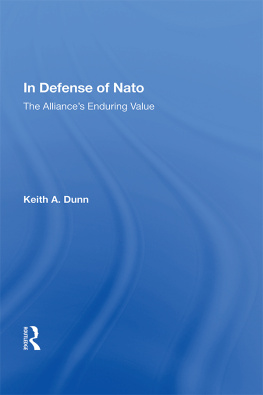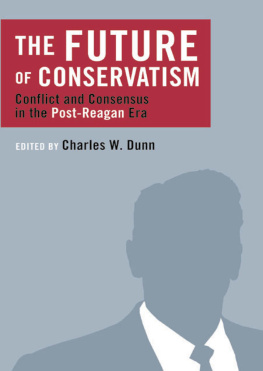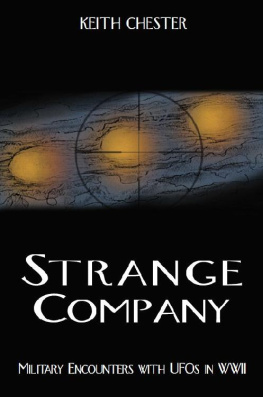ALTERNATIVE MILITARY STRATEGIES FOR THE FUTURE
Also of Interest from Westview Press
Military Strategy in Transition: Defense and Deterrence in the 1980s, edited by Keith A. Dunn and William O. Staudenmaier
International Security Yearbook 1984/85, edited by Barry M. Blechman and Edward N. Luttwak
Polarity and War: The Changing Structure of International Conflict, edited by Alan Ned Sabrosky
NATO: The Next Generation, edited by Robert E. Hunter
Maneuver Warfare Handbook, William S. Lind
The U.S. Navy: A Perspective from the Mid-1980s, edited by James L. George
Army Manpower Economics, edited by Curtis L. Gilroy
Central Organizations for Defense, edited by Martin Edmonds
Defense Facts of Life: The Plans/Reality Mismatch, Franklin C. Spinney, edited and with commentary by James Clay Thompson
Intelligence: Policy and Process, edited by Alfred C. Maurer, Marion D. Tunstall, and James M. Keagle
The Politics of Resource Allocation in the U.S. Department of Defense, Alex Mintz
The MX Decision: A New Direction in Weapons Procurement Policy? Lauren H. Holland and Robert A. Hoover
Nuclear Strategy, Arms Control, and the Future, edited by P. Edward Haley, David M. Keithly, and Jack Merritt
Available in hardcover and paperback
About the Book and Editors
In this volume, prominent civilian and military experts in defense, representing the maritime-continental coalition, military reform, and noninterventionist schools of thought, outline the changes in military strategy, policy, and force structure that they believe the United States must adopt if it is to cope successfully with threats to national security in the 1980s and 1990s. The authors analyze US interests and objectives, the changing strategic environment, and the major security threats facing the United States in the coming decades. They also discuss what they believe is the proper mix of political, economic, and military instruments for dealing with fixture threats. The alternative strategies they present are wide-ranging and comprehensive, running the gamut from a strategic withdrawal from global commitments to proposals for increasing US power projection and forcible entry capabilities in the Third World. In many ways the chapters are critical of current and past approaches to military strategy. The authors believe it is essential that strategists understand the existing critiques of current U.S. military strategy in order to make the correct policy decisions for the future.
Keith A. Dunn is a senior fellow at the Strategic Concepts Development Center at National Defense University and was formerly the senior policy analyst at the Strategic Studies Institute, US Army War College. Colonel William O. Staudenmaier is director of strategy at the Center for Land Warfare, US Army War College.
To
Christina and Drew
K.A.D.
Bill, Ris, and Shelby
W.O.S.
Alternative Military Strategies for the Future
Edited by
Keith A. Dunn
William O. Staudenmaier
Foreword by Robert W. Komer
First published 1985 by Westview Press
Published 2018 by Routledge
52 Vanderbilt Avenue, New York, NY 10017
2 Park Square, Milton Park, Abingdon, Oxon OX14 4RN
Routledge is an imprint of the Taylor & Francis Group, an informa business
Copyright 1985 Taylor & Francis
All rights reserved. No part of this book may be reprinted or reproduced or utilised in any form or by any electronic, mechanical, or other means, now known or hereafter invented, including photocopying and recording, or in any information storage or retrieval system, without permission in writing from the publishers.
Notice:
Product or corporate names may be trademarks or registered trademarks, and are used only for identification and explanation without intent to infringe.
Library of Congress Catalog Card Number: 85-8917
ISBN 13: 978-0-367-00527-6 (hbk)
Contents
Ambassador Robert W. Komer
Keith A. Dunn and William O. Staudenmaier
Christopher Makins
Lawrence T. Caldwell
James K. Oliver and James A. Nathan
Barry R. Posen
William S. Lind
Edward N. Luttwak
Jeffrey Record
Earl C. Ravenal
Keith A. Dunn and William O. Staudenmaier
This volume evolved from a conference held in November 1983 sponsored by the Strategic Studies Institute and held at the US Army War College. The conference participants, drawn from both the academic world and government, were brought together to discuss alternative military strategies and to address the following basic question: Has the strategic environment changed so radically in recent years that the United States must alter the basic premises that have underscored US military strategy for the last forty years?
In this volume eleven specialists analyze US interests and objectives, the changing strategic environment, and the major security threats facing the United States in the coming decades. They also discuss what they believe is the proper mix of political, economic, and military instruments for dealing with future threats to US interests and objectives.
A summary of the contributors' major points is found in . In the concluding chapter, after considering the diverse and often provocative views of the other contributors, we offer an integrated policy, strategy, and force structure that we feel is appropriate for America's entry into the 21st century.
Our grateful appreciation is extended to LTG Richard Lawrence, who was Commandant of the US Army War College when this conference was originally conceived, and to MG Thomas Healy, the current Commandant, who hosted the conference. We gratefully acknowledge the generous support provided by the US Army War College Foundation, Inc., and its Executive Director, Colonel LeRoy Strong, USA (Ret.). Without the Foundation's and Colonel Strong's active support, the conference could not have been convened with such a distinguished group of participants. Also, we want to express our appreciation to the conference participants, who took time from their busy schedules to play an active role in the conference. Their perceptive comments helped the contributors to sharpen their arguments for publication. The conference participants are listed at the end of the book. Working with the contributors has been an enjoyable, rewarding experience, and we wish to express our appreciation for their cooperation. Special thanks are due to Deloris Hutchinson, Nancy Allen, and Gloria Bush whose diligent efforts led to a completed manuscript. As always, the support that we received from the US Army War College Reprographics Division was outstanding. Charles Owens, chief of the Reprographics Division, and Priscilla Alspaugh and Carol Wentzel provided indispensable assistance in preparing this volume in its final form.
This book is dedicated not only to our children but also to all of the children of the contributors. We hope that if their parents think about strategy and war rationally, the promise of the US Army War College's motto"Not to promote war but to preserve peace by intelligent and adequate preparation..."will be fulfilled.












